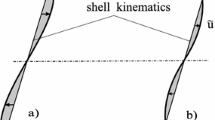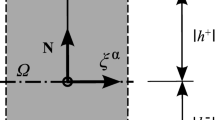Abstract
In this paper layered composite shells subjected to static loading are considered. The theory is based on a multi-field functional, where the associated Euler–Lagrange equations include besides the global shell equations formulated in stress resultants, the local in-plane equilibrium in terms of stresses and a constraint which enforces the correct shape of warping through the thickness. Within representative volume elements warping displacements are interpolated with layerwise cubic functions in thickness direction and constant shape throughout the reference surface. Elimination of warping and Lagrange parameters by static condensation leads to a material matrix for the stress resultants and to shear correction factors for layered plates and shells. For linear elasticity the computation can be done once in advance. The condensed material matrix is used in displacement based elements along with the enhanced strain method or in mixed hybrid elements with the usual 5 or 6 nodal degrees of freedom. This allows standard geometrical boundary conditions and the elements are applicable also to shell intersection problems. The interlaminar shear stresses are evaluated via the constitutive law by back substitution of the eliminated parameters. The computed transverse shear stresses are automatically continuous at the layer boundaries and zero at the outer surfaces. Furthermore, the integrals of the shear stresses coincide exactly with the shear forces without introduction of further constraints.


























Similar content being viewed by others
References
Mittelstedt C, Becker W (2004) Interlaminar stress concentrations in layered structures, Part I: a selective literature survey on the free-edge effect since 1967. J Compos Mater 38:1037–1062
Zhang Y, Yang C (2009) Recent developments in finite element analysis for laminated composite plates. Compos Struct 88:147–157
Chaudhuri RA (1986) An equilibrium method for prediction of transverse shear stresses in a thick laminated plate. Comput Struct 23(2):139–146
Schürg M, Wagner W, Gruttmann F (2009) An enhanced FSDT model for the calculation of interlaminar shear stresses in composite plate structures. Comput Mech 44(6):765–776
Vidal P, Gallimard L, Polit O (2013) Proper generalized decomposition and layer-wise approach for the modeling of composite plate structures. Int J Solids Struct 50:2239–2250
Auricchio F, Sacco E (1999) A mixed-enhanced finite-element for the analysis of laminated composite plates. Int J Numer Methods Eng 44:1481–1504
Auricchio F, Sacco E, Vairo G (2006) A mixed FSDT finite element for monoclinic laminated plates. Comput Struct 84:624–639
Auricchio F, Balduzzi G, Khoshgoftar MJ, Rahimi G, Sacco E (2014) Enhanced modeling approach for multilayer anisotropic plates based on dimension reduction method and Hellinger–Reissner principle. Compos Struct 118:622–633
Brank B, Carrera E (2000) Multilayered shell finite element with interlaminar continuous shear stresses: a refinement of the Reissner–Mindlin formulation. Int J Numer Methods Eng 48:843–874
Zhen W, Lo SH, Xiaohui R (2015) A \(C^0\) zig-zag model for the analysis of angle-ply composite thick plates. Compos Struct 127:211–223
Reddy JN (1984) A simple high-order theory for laminated composite plates. J Appl Mech 51:745–752
Robbins DH, Reddy JN (1993) Modelling of thick composites using a layerwise laminate theory. Int J Numer Methods Eng 36:655–677
Carrera E (2003) Theories and finite elements for multilayered plates and shells: a unified compact formulation with numerical assessment and benchmarking. Arch Comput Methods Eng 10(3):215–296
Zhen W, Wanji C (2010) A global-local higher order theory including interlaminar stress continuity and \(C^0\) plate bending element for cross-ply laminated composite plates. Comput Mech 45:387–400
Kulikov GM, Plotnikova SV (2013) Advanced formulation for laminated composite shells: 3D stress analysis and rigid-body motions. Compos Struct 95:236–246
Han S, Bauchau OA (2016) A novel, single-layer model for composite plates using local-global approach. Eur J Mech Solids 60:1–16
Carrera E, Cinefra M, Lamberti A, Petrolo M (2015) Results on best theories for metallic and laminated shells including layer-wise models. Compos Struct 126:285–298
Dorninger K (1991) A nonlinear layered shell finite element with improved transverse shear behavior. Compos Eng 1(4):211–224
Gruttmann F, Wagner W, Meyer L, Wriggers P (1993) A nonlinear composite shell element with continuous interlaminar stresses. Comput Mech 13:175–188
Gruttmann F, Wagner W (1994) On the numerical analysis of local effects in composite structures. Compos Struct 29:1–12
Gruttmann F, Wagner W (1996) Coupling of 2d- and 3d-composite shell elements in linear and nonlinear applications. Comput Methods Appl Mech Eng 129:271–287
Marimuthu R, Sundaresan MK, Rao GV (2003) Estimation of interlaminar stresses in laminated plates subjected to transverse loading using three-dimensional mixed finite element formulation. The institution of engineers (India). Tech J Aerosp Eng 84:1–8
Klinkel S, Gruttmann F, Wagner W (1999) A continuum based 3D-shell element for laminated structures. Comput Struct 71:43–62
Timoshenko SP (1921) On the correction for shear of the differential equation for transverse vibrations of prismatic bars. Philos Mag Ser 6(41):245, 744–746
Whitney JM (1972) Stress analysis of thick laminated composite and sandwich plates. J Comput Mater 6:426–440
Whitney JM (1973) Shear correction factors for orthotropic laminates under static load. J Appl Mech 40:302–304
Noor AK, Peters JM (1989) A posteriori estimates for shear correction factors in multilayered composite cylinders. J Eng Mech 115:1225–1244
Klarmann R, Schweizerhof K (1993) A Priori Verbesserung von Schubkorrekturfaktoren zur Berechnung von geschichteten anisotropen Schalentragwerken. Arch Appl Mech 63:73–85
Pai PF (1995) A new look at shear correction factors and warping functions of anisotropic laminates. Int J Solids Struct 32(16):2295–2313
Laitinen M, Lahtinen H, Sjölind SG (1995) Transverse shear correction factors for laminates in cylindrical bending. Commun Numer Methods Eng 11:41–47
Birman V, Bert CW (2002) On the choice of shear correction factor in sandwich structures. J Sandw Struct Mater 4(1):83–95
Altenbach H, Naumenko K (2002) Shear correction factors in creep-damage analysis of beams, plates and shells. JSME Int J Ser A 45:77–83
Shariyat M, Alipour M (2013) Semi-analytical consistent zigzag-elasticity formulations with implicit layerwise shear correction factors for dynamic stress analysis of sandwich circular plates with fgm layers. Compos Part B 49:43–64
Altenbach H, Eremeyev VA, Naumenko K (2015) On the use of the first order shear deformation plate theory for the analysis of three-layer plates with thin soft core layer. ZAMM 95(10):1004–1011
Gruttmann F, Wagner W, Knust G (2016) A coupled global-local shell model with continuous interlaminar shear stresses. Comput Mech 57:237–255
Gruttmann F, Wagner W (2006) Structural analysis of composite laminates using a mixed hybrid shell element. Comput Mech 37:479–497
Bach C, Baumann R (1924) Elastizität und Festigkeit, 9th edn. Springer, Berlin
Reissner E (1947) On bending of elastic plates. Q Appl Math 5:55–68
Dvorkin E, Bathe KJ (1984) A continuum mechanics based four node shell element for general nonlinear analysis. Eng Comput 1:77–88
Simo JC, Rifai MS (1990) A class of mixed assumed strain methods and the method of incompatible modes. Int J Numer Methods Eng 29:1595–1638
Balzani D, Gruttmann F, Schröder J (2008) Analysis of thin shells using anisotropic polyconvex energy densities. Comput Methods Appl Mech Eng 197:1015–1032
Wagner W, Gruttmann F (2005) A robust nonlinear mixed hybrid quadrilateral shell element. Int J Numer Methods Eng 64:635–666
Taylor RL (2016) FEAP. http://www.ce.berkeley.edu/projects/feap/
Schenk O, Gärtner K (2004) Solving unsymmetric sparse systems of linear equations with PARDISO. J Futur Gener Comput Syst 20(3):475–487
Author information
Authors and Affiliations
Corresponding author
Additional information
Dedicated to Prof. em. Dr.-Ing. habil. Dr.-Ing. E.h. Dr. h.c. mult. Erwin Stein on the occasion of his 85th birthday.
Rights and permissions
About this article
Cite this article
Gruttmann, F., Wagner, W. Shear correction factors for layered plates and shells. Comput Mech 59, 129–146 (2017). https://doi.org/10.1007/s00466-016-1339-2
Received:
Accepted:
Published:
Issue Date:
DOI: https://doi.org/10.1007/s00466-016-1339-2




